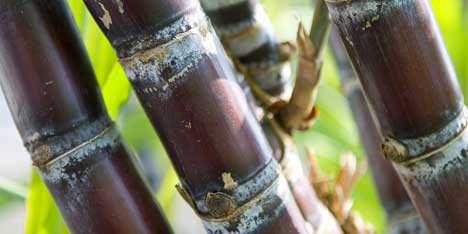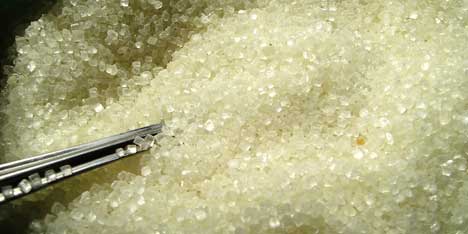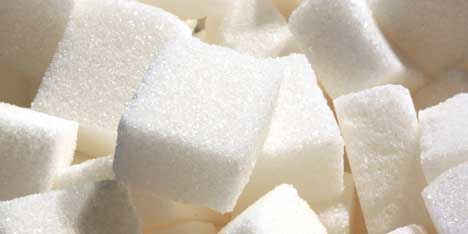The Many Names of Sugar
To keep the amount of sugar that you consume in check, you must be aware which foods contain high amounts of it. Luckily, here in the United States, manufacturers of packaged foods must disclose the list of ingredients on the packaging. And although the list doesn't have to specify the exact amounts, the ingredients do have to be listed in order, with the most prevalent ingredient first. So it should be easy to find out which foods are high in sugar, right? Yes, but first you must learn the many names of sugar.
To keep the amount of sugar that you consume in check, you must be aware which foods contain high amounts of it. Luckily, here in the United States, manufacturers of packaged foods must disclose the list of ingredients on the packaging. And although the list doesn't have to specify the exact amounts, the ingredients do have to be listed in order, with the most prevalent ingredient first. So it should be easy to find out which foods are high in sugar, right? Yes, but first you must learn the many names of sugar.
Sugar
The problems associated with a diet that is high in sugar are well known. Here is a brief recap: consistent consumption of too much sugar can lead to an increase of body fat, tooth decay, diabetes, and suppression of the immune system.
Sugar adds calories to your diet, and not much else.
Sugar has a high glycemic index. That means that its consumption raises the blood insulin level quickly. Insulin tells the body to store glucose as fat. Also, a rise in insulin makes you feel hungry. In other words, foods with a high glycemic index make you fat and hungry.
The problems associated with a diet that is high in sugar are well known. Here is a brief recap: consistent consumption of too much sugar can lead to an increase of body fat, tooth decay, diabetes, and suppression of the immune system.
Sugar adds calories to your diet, and not much else.
Sugar has a high glycemic index. That means that its consumption raises the blood insulin level quickly. Insulin tells the body to store glucose as fat. Also, a rise in insulin makes you feel hungry. In other words, foods with a high glycemic index make you fat and hungry.
Cut It Out?
So should sugar always be avoided? Of course not. A food that contains a moderate amount of sugar, along with a good amount of other nutrients, such as fiber, complex carbohydrates, protein, or indeed fat, won't have a high glycemic index, and won't have all the undesirable effects on the body.
The only time that consuming a significant dose of high glycemic sugars is beneficial is immediately after strenuous exercise, to replenish muscle glycogen.

Sugar Substitutes
The food industry uses many different sweeteners that are nutritionally equivalent to sugar.
They include:
- Corn Syrup
- Corn Syrup Solids
- Dextrose
- Evaporated Cane Juice
- Fructose
- Glucose
- Grape Juice Concentrate
- High Fructose Corn Syrup
- Honey
- Maltodextrin (see below)
- Molasses
- Saccharose
- Sucrose
The nutritional differences between these sweeteners for the consumer are negligible. All of them have the same dietary concerns as plain sugar. They all have a high glycemic index, and they all have the same amount of calories. (Maltodextrin is not sweet, but it is the same in terms of calories and glycemic index)
Whenever you see any of these terms on the ingredients list, translate it to "sugar".

Refined or Unrefined
Unrefined sugar, unrefined evaporated cane juice, and so on, contain trace amounts of vitamins and minerals. But the amount of calories is the same as refined sugar, the glycemic index is still high, and those vitamins and minerals are more abundantly found in other foods.
For example, unrefined evaporated cane juice is said to be a good source of riboflavin (also called vitamin B2). But a cup of (non-fat, unsweetened) yogurt has the same amount of riboflavin as 24 teaspoons of unrefined evaporated cane juice. That amount of yogurt has 137 calories, 14 grams of protein, and a glycemic index of 36 (low). The evaporated cane juice has 400 calories, no protein, and a glycemic index of 55. Really, don't bother with unrefined sugar for the nutrition.
Added Sugar
As far as your body is concerned, sugar is sugar, regardless of whether it is an added ingredient, or naturally occurring. The glycemic index, the calories, the tooth decay, all the problems of sugar are the same with naturally occurring sugar.
The foods with the highest amounts of naturally occurring sugar are fruits. When you eat fruit, this is not a big problem. A single piece of fruit is really only a small amount of food, which has a small amount of sugar, and comes packed with fiber and other useful nutrients, in significant amounts.
But it's a different story when fruits are processed, juiced, or concentrated. A 12 oz glass of orange juice contains the juice of four and a half oranges, so the sugar of four and a half oranges hits your system all at once. That is a lot. Remember, a glass of orange juice contains the same amount of sugar as a glass of soda.
So even if a food has no sugar added, it can still be a high sugar food, especially if it is, or contains fruit juice.

